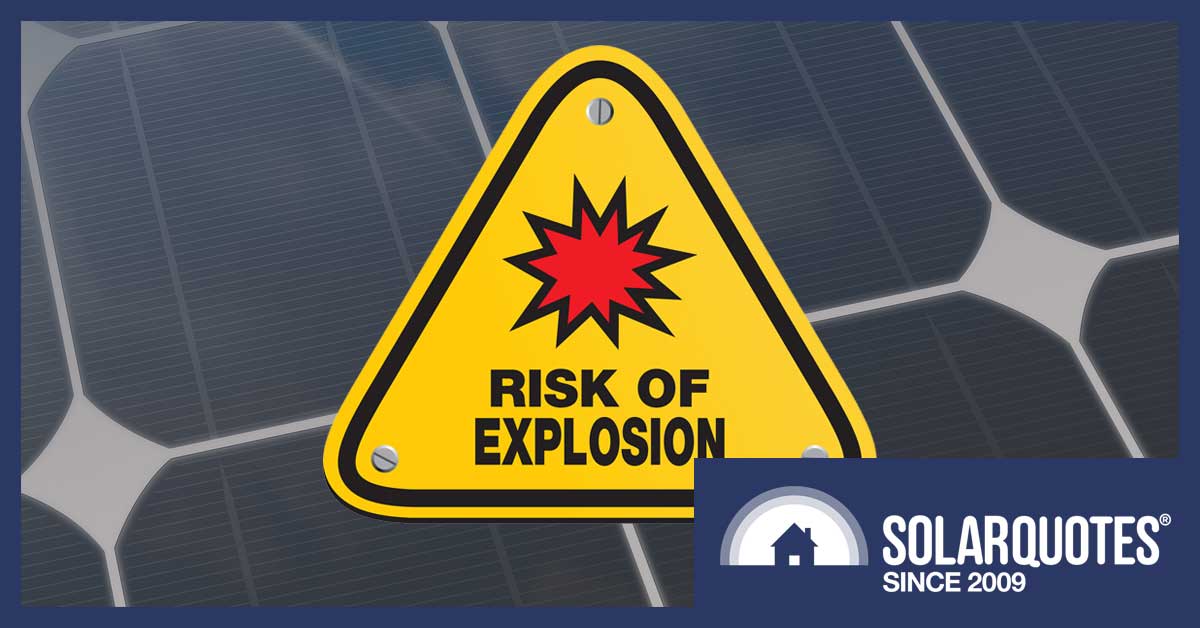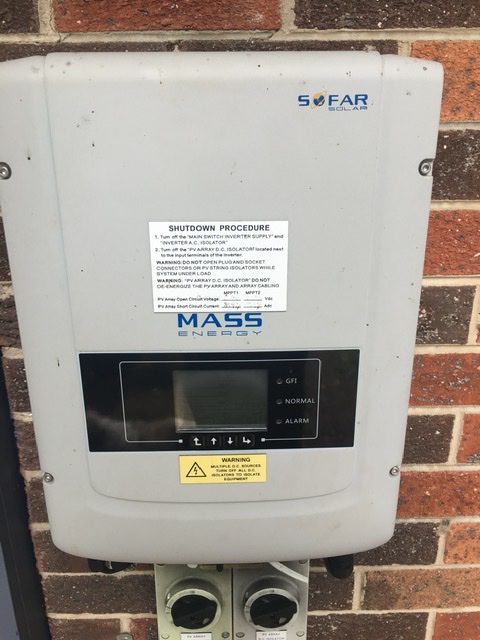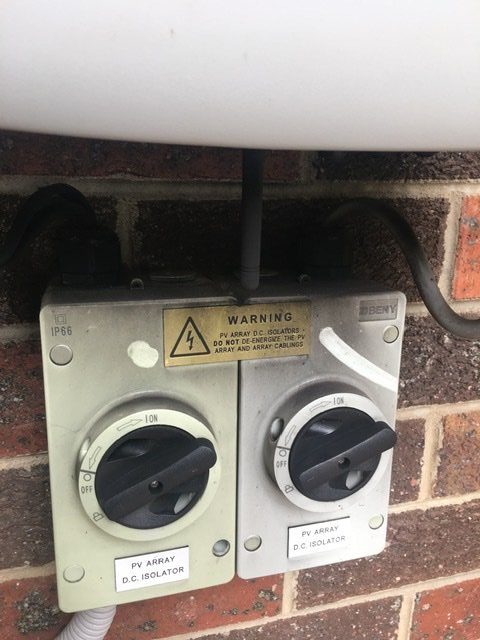
De-energising a solar system can be dangerous if done incorrectly.
Alliance Solar doesn’t seem to have a media manager, and that’s a problem, because we reckon a bit of crisis communications will be in order. SolarQuotes emailed the company at its only public address, the ubiquitous info@ format, because its website doesn’t mention a media contact.
Why? Because a solar power system owner has posted tales of exploding kit in their reviews of Alliance Solar.
The solar isolator explosion, which seem to arise from tech support telling people to disconnect an isolator while the system is under load, have also alerted an Alliance Solar customer, Peta and Lee, that their inverter brand was subject to a recall last year.
There was Peta’s review, which said:
“We had our system installed two years ago. The alarm light came up recently so my husband called to report an issue. He was talked through a shutdown process and the unit proceeded to blow up in his face. Yep! He could of been killed . Nearly two weeks later no response from customer service so I did some googling today. I found out that the inverter brand we were sold was recalled two months after we bought it as it does not meet Australian standards and is potentially dangerous. I’m beyond shocked and will be contacting the ombudsman in the morning.”
We confirmed the details of the review in conversation with Peta last week, and in addition Lee added:
“Sales person was good enough. Promised the world at an acceptable price for the ‘German Technology’. Chinese Products installed with incorrect frames.
Inverter blew up in my face whilst the ‘Technician’ on the other end of the phone talked me through a reset procedure. After some digging we found out that the brand we had been sold was recalled shortly after installation.
I suspect from the huge flash, the bang that put me on my arse, and the smoke emanating from the box that If I had been in contact with it at the time things could have been much worse.”
We would like to talk to Alliance Solar about this, but as I said, the company hasn’t responded to our e-mail.
So what’s going on? Peta’s photos provide a hint.

Peta’s damaged isolator, and the recalled inverter. Image: supplied

Close-up of the damaged isolator
As you can see, it’s the isolator that went “bang” rather than the inverter, and to find out why this would happen we talked to Abs Sultan of Sunseeker Electrical. He explained that in larger systems where strings of solar panels are connected in parallel, users must not shut off solar panel isolators if the system is under load.
Where people most often get it wrong is when a fault on the system raises an alarm, and they have to reset the inverter.
“Say you have 30 amps on a string – if you try to just shut it off, you send that 30 amps back up to the isolator.”
“This happens when you have strings in parallel on the roof – a fault will happen in one string, and when you cut it off, it will try to run through the other string, it will go through the other isolator.”
From Finn:
A warning to homeowners: if you are not confident how to reset a solar inverter safely – don’t.
A warning to solar companies: be very careful if asking a customer to reset their solar inverter over the phone – if at all possible physically do it for them. Even if you give them the correct instructions, from the other end of the phone it is hard to be sure they are switching off the inverter’s AC isolator, not the DC isolator(s).
Abs sent us a video showing just how dramatic it can be if you get it wrong!
In Peta’s case, the solar isolator accident sent them Googling the inverters, and that’s how they discovered the Sofar inverter brand was subject to a recall that came into effect last year. The ACCC’s recall notice is here. The recall notice says the inverter can be fixed by a technician visiting, upgrading the firmware and attaching a sticker warning of hot surfaces. The fact that Peta’s inverter has no ‘hot surface’ warning sticker suggests that this work has not been done on her inverter.
Peta told us that after many contacts, she’s been promised a replacement inverter.
We would also like to ask Alliance Solar about their process when one of the brands they sell is subject to a recall, but we still haven’t heard back from the company.
Recall Processes
The case highlights what we think is a problem for the solar industry – the fragmented handling of recalls.
If we were talking about motor vehicles, the line between recall and consumer is very short. Take the Takata airbag for example: auto manufacturers (28 of them so far) are required to be proactive in seeking out car-owners affected by the recall. It’s only people who the industry hasn’t located who have to call the manufacturer’s help line, which is provided in the ACCC’s Takata airbag recall notice.
In our industry, the Clean Energy Council will remove recalled products from its approved products list, but Finn explained to me that the CEC are not a regulator and cannot take responsibility for recalling products. That responsibility lies with the ACCC, which administers Product Safety Australia and publishes recall notices.
Unfortunately the fragmented nature of the solar industry (and the electrical industry in general), with thousands of companies selling solar power systems, means product recalls are dependent on either the consumer realising they have a recalled product or each solar company notifying the consumer. As a result there are still recalled products on people’s homes that have not been fixed or replaced.
If you are concerned about your system, you can see a list of solar-related recalls listed by the CEC here.

 RSS - Posts
RSS - Posts



Not a clear explanation I’m afraid.
Can the CER not intervene and blacklist Alliance Solar (AND its principals), and, any other such company, for such behaviour?
Similarly, does the applicable state not have a means for deregistering electrical contractors, in cases like this, and, banning companies like Alliance Solar (AND its principals), from being involved in, or, commissioning, any electrical work?
And, does whatever institution that is responsible for the applicable electricity grid, have the power to blacklist the company (AND its principals) and any of their minions, from doing any electrical work involving anything connected to the grid? I wonder what could happen, if such faultiness went up the grid, and, blew a local grid fuse, in addition to the damage at the residence
Once again, this goes to my post about the problems and complaints in WA; relating to the bodginess of the industry, due to lack of proper regulation.
I note that, with the above comment by Finn, “it is hard to be sure they are switching off the correct isolators in the correct order.”, when our two systems, with two inverters, were installed, the sequence for shutting down the systems, and, restarting the systems, in terms of the isolators, was explicit, and displayed, on each inverter.
When the two inverters were replaced with a single inverter, and I mentioned that no sequence for the isolators switched was specified, the technician told me that he regarded the sequence of switching, to be of no consequence, and not worth bothering about.
I had, on occasion, used the shutdown and startup switching sequences, as specified on the first system, and, it worked without any problems, but, now, with the replacement single inverter, with two strings of panels, the instructions are gone, because the inverters are gone, and, the technician that installed the replacement inverter, said it doesn’t matter in which order, the isolators are switched on and off.
I am very disillusioned with the ‘regulatory’ role of the industry. When something goes wrong they blame the property owner to fix it (my experience)? The industry needs to be better regulated! One has to be concerned aas to the o/s installation and components being suitable for Australia conditios?
I dunno RE, the building trades all have the same issues. Just look at the Units/Apartments debacle that is going on in Sydney.
I think we should placing errant tradies under public supervision initially, then deregistering them and finally jailing them if they don’t lift their game.
And we need more surprise inspections in Regional areas.
As Robert Cutcher says above, not a very good explanation..
What kind of panels produce 30A in a single string?
Surely the issue when switching off a string under load is high voltage DC arcing, which may indeed seem like an explosion?
Why will the current (surely = zero in that string once the isolator is opened) “try to run through the other string” when you have 2 strings in parallel?